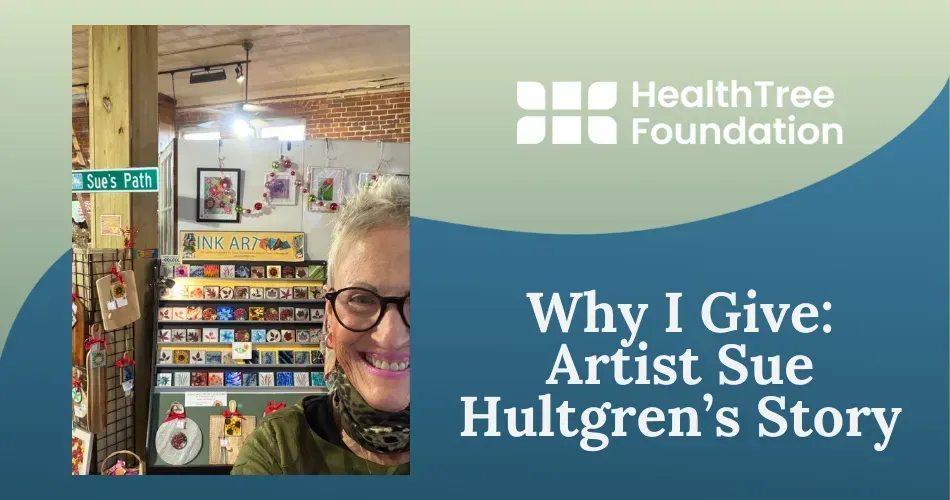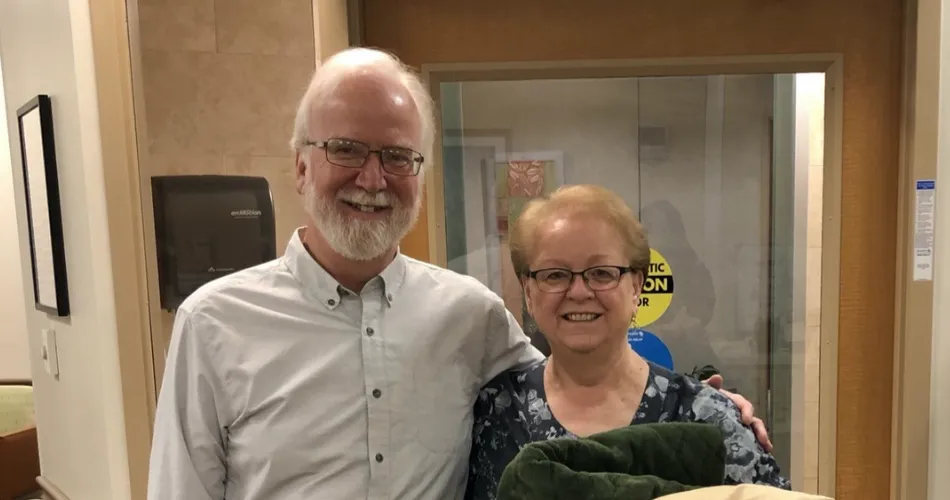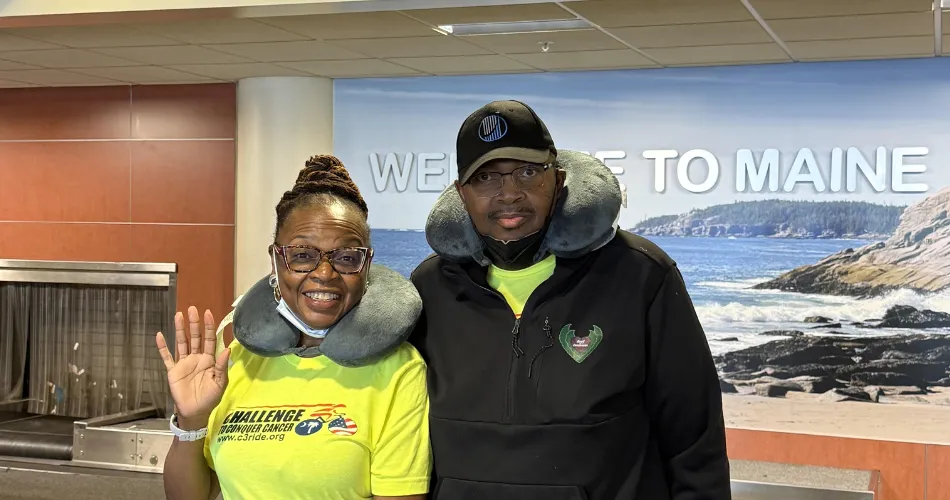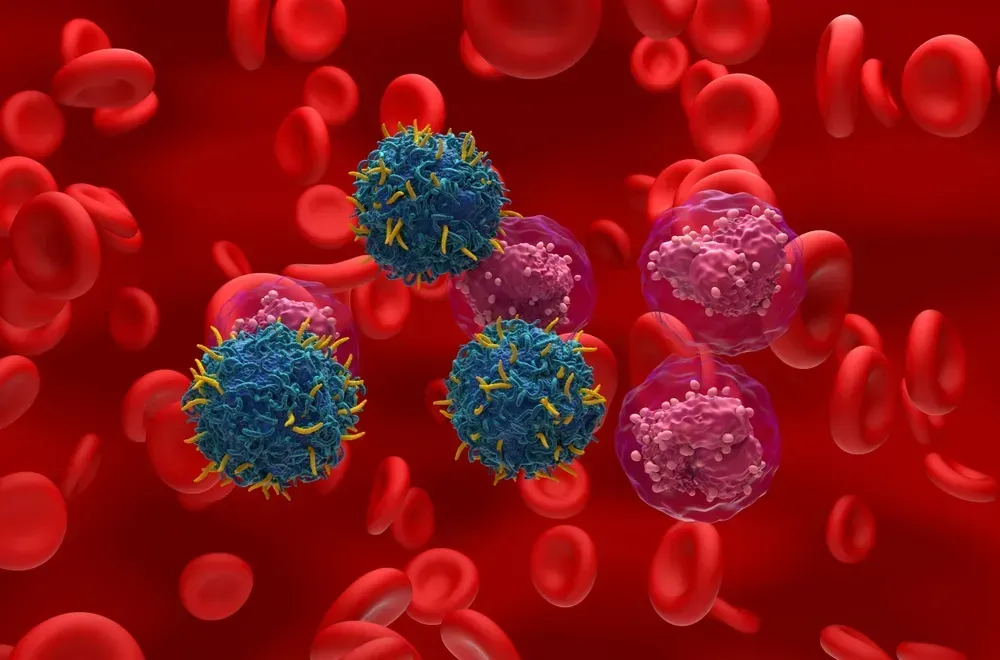My CAR-T Therapy Experience: A Myeloma Patient Story
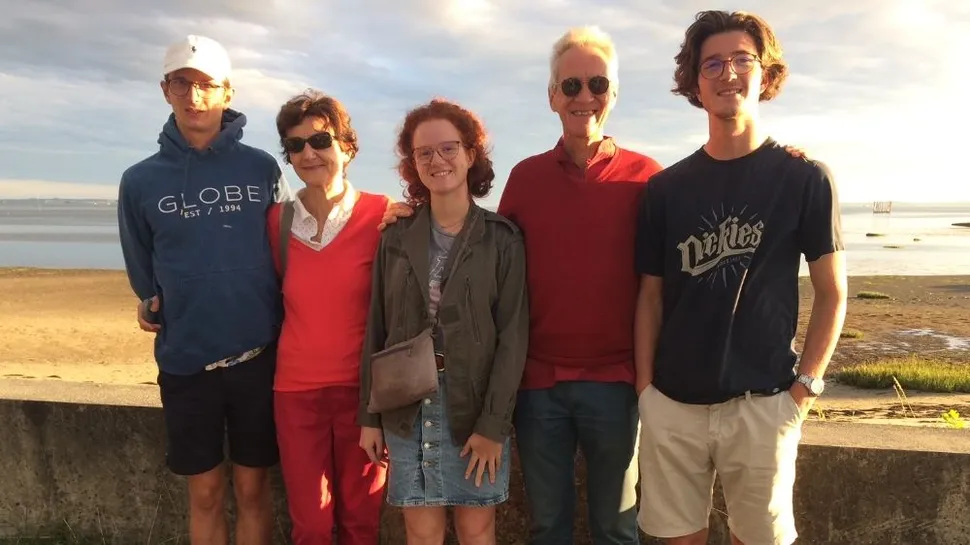
The following story was written by William Kenneth Casler from Paris, France, who details his experience receiving CAR-T therapy for his multiple myeloma treatment.
Kenneth's Background
In October 2009, at the age of 61, I was diagnosed with multiple myeloma with high-risk cytogenetics (1q21 gain – 3 copies).
I had never heard of the condition, but I will always remember the hematologist saying: “Well, it’s not good, but you should be confident. A lot is happening in the field. With a bit of luck, you should benefit." She was right.
Treatment began in the spring of 2010 with an Autologous Stem Cell Transplant (ASCT). It was successful and I was in remission until early 2014.
My second line of treatment was with REVLIMID®, an immunomodulatory drug. It worked for about 20 months. I relapsed in late 2016.
In January 2017, I joined a clinical trial, investigating the impact of an anti-CD38 antibody combined with a proteasome inhibitor and a corticosteroid, the triplet daratumamab-carfilzomib-dexamethasone. Rapid disease progression required me to leave the trial in August 2018 after 22 months.
In December of that same year, I received a second stem cell transplant. This was followed by lengthy maintenance with pomalidomide until late 2021.
In December 2021, I was admitted into the Emergency Care Unit of Saint-Louis Hospital in Paris with acute pneumonia and septicemia. During my two-week hospitalization, my hematologist and I discussed further treatment options.
The CAR-T Experience from a Myeloma Patient Perspective
The first commercial CAR-T, ABECMA, had been approved for use in France in August 2021. Only 10 slots per month were available for the entire country. The multiple myeloma community in France numbers over 30,000 individuals. Perhaps a thousand or more are in need of immediate CAR-T therapy.
Understandably, the 10 slots were highly coveted. Moreover, there were strong signs that the early access authorization would be withdrawn. The reason was unspecified, but probably related to the lack of a cost-benefit analysis with a standard-of-care comparator.
I first heard about CAR-T therapy from a young doctor when I was on a clinical trial in 2017. We frequently discussed therapeutic innovations under investigation and CAR-T came up. I told him it was an option I was interested in if the opportunity arose and I could qualify. He noted that.
In early January 2022, my hematologist told me I would be a good candidate for a CAR-T and asked if I was interested. I was indeed. I knew another CAR-T product with higher response rates was on the horizon and likely to be approved soon.
My hematologist explained that approval and access were still six to nine months away and, in light of my progressing disease, I could hardly wait that long.
As the saying goes: a bird in the hand is worth two in the bush, which translates today as: the best CAR-T is the one you can get. I accepted the offer.
Approval Process & Bridging Therapy
In January 2022, Saint-Louis Hospital in Paris filed my application for treatment. It was approved in early February with an infusion date scheduled for early to mid-April 2022.
Many patients and healthcare professionals now realize that the scheduled date for delivery and infusion is rarely met. This can be explained by manufacturing delays and other complicating issues. Sadly, some patients never make it to the starting line because of progressing disease.
I was nearly 74 years old at the time, but quite fit for my age. My overall health was good. And although I had been identified with aggressive myeloma, I had always responded well to my various lines of treatments.
The first hurdle I encountered in the approval process was with the hospital’s cardiologist who found damage to the left ventricle of my heart, no doubt due to the high-dose chemotherapies and various myeloma-specific medicines I had received over the years. This was a virtual red card. I hoped my hematologist could find a way around the issue. She did.
A further hurdle in the process is rapid disease progression and the need for bridging therapy. Until now, patients who qualify for CAR-T therapy are required to have had at least four prior lines of treatment.
Basically, we are heavily pretreated with progressing disease, so almost out of options. As a consequence, a time-lapse of 4 or more months before CAR-T infusion can be too long for some, even with bridging therapy. As my myeloma was progressing somewhat slowly, I was fortunate not to require bridging therapy.
Leukapheresis & Re-engineering of T-cells
Living with myeloma is full of uncertainty and involves a lot of stress. The collection of the patient’s T-cells is just one more challenging moment to navigate.
Patients who have had a stem cell transplant will be familiar with the process. In 2010 I spent 5 days, 5 hours a day, on the apheresis machine to collect enough stem cells for two transplants.
In contrast, leukapheresis, the collection of lymphocytes, took in my case only 5 hours in a single session. On the whole (for most patients) it is faster and less demanding than stem cell collection (sometimes known as apheresis).
Another issue of patient concern is the quality of the collected lymphocytes. The many prior lines of myeloma treatment and the disease itself have an impact on our T-cell quality. It is only once the T-cells have been sent to the laboratory for re-engineering and expansion that any certainty emerges regarding the ultimate phase of treatment.
Hospitalization & Reinfusion for the CAR-T Therapy Treatment
I was admitted to the hospital in mid-May 2022, a full month later than scheduled. The logistics of re-engineering and manufacturing my lymphocytes had run less smoothly than planned. In the end, it had taken almost six weeks longer. Again, fortunately for me, my myeloma was progressing slowly.
Day 1 of hospitalization was devoted to final consultations with my hematologist, a cardiologist, and a neurologist. In my case, everything went without a hitch. On Day 2, lymphodepletion, a short 3-day course of chemotherapy, was initiated.
The process of lymphodepletion, involving two chemotherapeutic medications, is similar to the process used in a stem cell transplant, though the agents are different. The purpose is to eliminate the patient’s existing lymphocytes to create space for the re-engineered T-cells.
My prior experience of two stem cell transplants had me thinking that recovery from the chemotherapy could be challenging, since I was now older. But just how difficult and long was another factor of uncertainty. In reality, my aplasia (the failure of an organ or tissue to develop or to function normally) lasted almost 6 months.
Finally, on Day 6 of hospitalization, two days after lymphodepletion, two small infusion bags of re-engineered T-cells arrived in my room. Within an hour the infusion process was over and done. Similar to a stem cell transplant, the process is straightforward. The challenges come after.
Side Effects & Management After CAR-T Therapy
I took a notebook with me to the hospital to document the CAR-T experience. There had been a lot of talk about side effects and I wanted to track them as closely as possible.
The Cytokine Release Syndrome, or CRS, arrived right on schedule. Grade 1 for me. Nothing more than a bad case of the flu with high fever, headache, and chills.
Then came the ICANs, i.e. the neurologic adverse reactions associated with CAR-T therapy. Unsurprisingly, there are no entries in my notebook for the three days following the re-infusion of T-cells. I was unable to write or put my thoughts in any kind of order.
One day a nurse found me wandering the hospital corridors. I told her that I had been authorized to get some exercise. In my wildest dreams! She gently guided me back to my room.
I also experienced the usual nausea, gastrointestinal issues, and aches and pains, together with insomnia. None of this was really challenging.
Perhaps most telling was the hematological toxicity which manifests itself in sinuous ways. I experienced a number of hematological adverse events that called for close attention:
- acute thrombocytopenia with platelets at 12,000 per microliter requiring 3 transfusions;
- severe anemia (7.6 dl), also resulting in 3 transfusions and regular EPO injections for almost a year;
- acute neutropenia
- Even today, 18 months later, my neutrophils and lymphocytes achieve only minimum acceptable levels, meaning I am highly susceptible to infection.
I continue to have hypogammaglobulinemia, which has never been treated with IVIG. It probably should be, because I routinely experience respiratory infections.
CRS, ICANS, hematological toxicities, and infections are undoubtedly the principal challenges facing CAR-T-treated myeloma patients.
Discharge & Further Developments
After 14 days I was released from the hospital and went home. Of course, it was still too early to know if I had actually responded to the therapy. That would take several more weeks and months before any certainty.
But it was a glorious feeling to be out and about, even if I did make weekly visits to the hospital over the next weeks and months for regular consultations and tests.
My plan upon arriving back home was to start exercising again to build up my stamina and regain the 7 kg I had lost during the hospital stay. What a disappointment when I discovered that I had no energy whatsoever.
One week after my discharge, I did find the strength to attend my first meeting to record an interview about my CAR-T experience for a patient organization.
A week after that I took the train to visit my grandchildren in Bordeaux, a two-hour journey away, so within the recommended timeframe. The following week, I traveled to Amsterdam for another patient organization event.
All the while I was taking lots of medicine, receiving weekly myeloid growth factor injections and additional blood transfusions. Unsurprisingly, I came down with an infection after about 5 weeks, experiencing loss of appetite, considerable fatigue, and enormous gastrointestinal complications.
By mid-July, I was back in the hospital with severe COVID-19, complicated by clostridium difficile (C.diff) and an astrovirus.
Paxlovid and convalescent plasma finally got the better of the COVID. Two weeks later I was back home, but only after I had lost another 7 kg. I now weighed a mere 55 kg for my 1m82 frame, down from my normal 70 kg. How was I ever going to climb back up that hill? I wondered.
In addition, I was consuming lots of medicine every day. Not the one-and-done I had hoped for.
It is obvious that I had been reckless with my running around. Perhaps I had not been sufficiently informed about the risks of infection after CAR-T therapy. But, then, who could have imagined that I would be so foolhardy?
Without a doubt, infections are the patient’s most serious concern over the short and medium term. Since my COVID episode, I have been hospitalized twice for respiratory infections and sepsis.
Back to Normal After CAR-T
It has been a year and a half since the re-infusion of my CAR-T cells. I am still in Complete Response (CR) with unquantifiable light chains and no detectable M-spike. I did not achieve the holy grail of MRD negativity.
I take only 3 antibiotics, an ACE inhibitor, and anti-asthma medication daily, but no myeloma-specific medication whatsoever. It’s a nice place to be.
In the past year, after my initial struggles with fatigue, weight loss, and infections, I have enjoyed frequent trips around Europe and as far away as South-East Asia and North America. Thankfully, all of these travels have been without a health incident.
I have also resumed my full range of physical activities: yoga classes at the studio every week, tennis two or three times a week, regular walks in the country (10 or 15 km an outing), and cycling around town.
Sadly, I have yet to resume my much-loved, long-distance cycling. Before the CAR-T, I thought nothing of a two-week, 1,000-km cycling trip somewhere in the world. Today, I can just about manage a 50 km outing, but even that is now comfortable only with an e-bike these days.
In short, my quality of life and overall health are about as good as it gets at 75 years of age. I never expected to enjoy such quality given my disease history.
I have no doubt that I will relapse one day, and that thought can trigger a storm of emotions. But at present, I can happily say that I am indeed a fortunate beneficiary of modern-day, innovative medicine. Carpe diem.
Resources
We thank Kenneth for his amazing story of resilience. If you are interested in sharing your story with our myeloma community, please email audrey@healthtree.org.
If you are interested in reading more myeloma patient stories, check them out here: Myeloma Patient and Caregiver Articles
If you would like to connect with other myeloma patients, find groups you're interested in on our platform here: HealthTree Connect
Learn more about CAR-T and other myeloma therapies from HealthTree University: HTU Know Your Therapy Unit
Have you signed up for HealthTree Cure Hub to track your disease and contribute to myeloma research? If not, do so today for free: HealthTree Cure Hub Sign-Up
The following story was written by William Kenneth Casler from Paris, France, who details his experience receiving CAR-T therapy for his multiple myeloma treatment.
Kenneth's Background
In October 2009, at the age of 61, I was diagnosed with multiple myeloma with high-risk cytogenetics (1q21 gain – 3 copies).
I had never heard of the condition, but I will always remember the hematologist saying: “Well, it’s not good, but you should be confident. A lot is happening in the field. With a bit of luck, you should benefit." She was right.
Treatment began in the spring of 2010 with an Autologous Stem Cell Transplant (ASCT). It was successful and I was in remission until early 2014.
My second line of treatment was with REVLIMID®, an immunomodulatory drug. It worked for about 20 months. I relapsed in late 2016.
In January 2017, I joined a clinical trial, investigating the impact of an anti-CD38 antibody combined with a proteasome inhibitor and a corticosteroid, the triplet daratumamab-carfilzomib-dexamethasone. Rapid disease progression required me to leave the trial in August 2018 after 22 months.
In December of that same year, I received a second stem cell transplant. This was followed by lengthy maintenance with pomalidomide until late 2021.
In December 2021, I was admitted into the Emergency Care Unit of Saint-Louis Hospital in Paris with acute pneumonia and septicemia. During my two-week hospitalization, my hematologist and I discussed further treatment options.
The CAR-T Experience from a Myeloma Patient Perspective
The first commercial CAR-T, ABECMA, had been approved for use in France in August 2021. Only 10 slots per month were available for the entire country. The multiple myeloma community in France numbers over 30,000 individuals. Perhaps a thousand or more are in need of immediate CAR-T therapy.
Understandably, the 10 slots were highly coveted. Moreover, there were strong signs that the early access authorization would be withdrawn. The reason was unspecified, but probably related to the lack of a cost-benefit analysis with a standard-of-care comparator.
I first heard about CAR-T therapy from a young doctor when I was on a clinical trial in 2017. We frequently discussed therapeutic innovations under investigation and CAR-T came up. I told him it was an option I was interested in if the opportunity arose and I could qualify. He noted that.
In early January 2022, my hematologist told me I would be a good candidate for a CAR-T and asked if I was interested. I was indeed. I knew another CAR-T product with higher response rates was on the horizon and likely to be approved soon.
My hematologist explained that approval and access were still six to nine months away and, in light of my progressing disease, I could hardly wait that long.
As the saying goes: a bird in the hand is worth two in the bush, which translates today as: the best CAR-T is the one you can get. I accepted the offer.
Approval Process & Bridging Therapy
In January 2022, Saint-Louis Hospital in Paris filed my application for treatment. It was approved in early February with an infusion date scheduled for early to mid-April 2022.
Many patients and healthcare professionals now realize that the scheduled date for delivery and infusion is rarely met. This can be explained by manufacturing delays and other complicating issues. Sadly, some patients never make it to the starting line because of progressing disease.
I was nearly 74 years old at the time, but quite fit for my age. My overall health was good. And although I had been identified with aggressive myeloma, I had always responded well to my various lines of treatments.
The first hurdle I encountered in the approval process was with the hospital’s cardiologist who found damage to the left ventricle of my heart, no doubt due to the high-dose chemotherapies and various myeloma-specific medicines I had received over the years. This was a virtual red card. I hoped my hematologist could find a way around the issue. She did.
A further hurdle in the process is rapid disease progression and the need for bridging therapy. Until now, patients who qualify for CAR-T therapy are required to have had at least four prior lines of treatment.
Basically, we are heavily pretreated with progressing disease, so almost out of options. As a consequence, a time-lapse of 4 or more months before CAR-T infusion can be too long for some, even with bridging therapy. As my myeloma was progressing somewhat slowly, I was fortunate not to require bridging therapy.
Leukapheresis & Re-engineering of T-cells
Living with myeloma is full of uncertainty and involves a lot of stress. The collection of the patient’s T-cells is just one more challenging moment to navigate.
Patients who have had a stem cell transplant will be familiar with the process. In 2010 I spent 5 days, 5 hours a day, on the apheresis machine to collect enough stem cells for two transplants.
In contrast, leukapheresis, the collection of lymphocytes, took in my case only 5 hours in a single session. On the whole (for most patients) it is faster and less demanding than stem cell collection (sometimes known as apheresis).
Another issue of patient concern is the quality of the collected lymphocytes. The many prior lines of myeloma treatment and the disease itself have an impact on our T-cell quality. It is only once the T-cells have been sent to the laboratory for re-engineering and expansion that any certainty emerges regarding the ultimate phase of treatment.
Hospitalization & Reinfusion for the CAR-T Therapy Treatment
I was admitted to the hospital in mid-May 2022, a full month later than scheduled. The logistics of re-engineering and manufacturing my lymphocytes had run less smoothly than planned. In the end, it had taken almost six weeks longer. Again, fortunately for me, my myeloma was progressing slowly.
Day 1 of hospitalization was devoted to final consultations with my hematologist, a cardiologist, and a neurologist. In my case, everything went without a hitch. On Day 2, lymphodepletion, a short 3-day course of chemotherapy, was initiated.
The process of lymphodepletion, involving two chemotherapeutic medications, is similar to the process used in a stem cell transplant, though the agents are different. The purpose is to eliminate the patient’s existing lymphocytes to create space for the re-engineered T-cells.
My prior experience of two stem cell transplants had me thinking that recovery from the chemotherapy could be challenging, since I was now older. But just how difficult and long was another factor of uncertainty. In reality, my aplasia (the failure of an organ or tissue to develop or to function normally) lasted almost 6 months.
Finally, on Day 6 of hospitalization, two days after lymphodepletion, two small infusion bags of re-engineered T-cells arrived in my room. Within an hour the infusion process was over and done. Similar to a stem cell transplant, the process is straightforward. The challenges come after.
Side Effects & Management After CAR-T Therapy
I took a notebook with me to the hospital to document the CAR-T experience. There had been a lot of talk about side effects and I wanted to track them as closely as possible.
The Cytokine Release Syndrome, or CRS, arrived right on schedule. Grade 1 for me. Nothing more than a bad case of the flu with high fever, headache, and chills.
Then came the ICANs, i.e. the neurologic adverse reactions associated with CAR-T therapy. Unsurprisingly, there are no entries in my notebook for the three days following the re-infusion of T-cells. I was unable to write or put my thoughts in any kind of order.
One day a nurse found me wandering the hospital corridors. I told her that I had been authorized to get some exercise. In my wildest dreams! She gently guided me back to my room.
I also experienced the usual nausea, gastrointestinal issues, and aches and pains, together with insomnia. None of this was really challenging.
Perhaps most telling was the hematological toxicity which manifests itself in sinuous ways. I experienced a number of hematological adverse events that called for close attention:
- acute thrombocytopenia with platelets at 12,000 per microliter requiring 3 transfusions;
- severe anemia (7.6 dl), also resulting in 3 transfusions and regular EPO injections for almost a year;
- acute neutropenia
- Even today, 18 months later, my neutrophils and lymphocytes achieve only minimum acceptable levels, meaning I am highly susceptible to infection.
I continue to have hypogammaglobulinemia, which has never been treated with IVIG. It probably should be, because I routinely experience respiratory infections.
CRS, ICANS, hematological toxicities, and infections are undoubtedly the principal challenges facing CAR-T-treated myeloma patients.
Discharge & Further Developments
After 14 days I was released from the hospital and went home. Of course, it was still too early to know if I had actually responded to the therapy. That would take several more weeks and months before any certainty.
But it was a glorious feeling to be out and about, even if I did make weekly visits to the hospital over the next weeks and months for regular consultations and tests.
My plan upon arriving back home was to start exercising again to build up my stamina and regain the 7 kg I had lost during the hospital stay. What a disappointment when I discovered that I had no energy whatsoever.
One week after my discharge, I did find the strength to attend my first meeting to record an interview about my CAR-T experience for a patient organization.
A week after that I took the train to visit my grandchildren in Bordeaux, a two-hour journey away, so within the recommended timeframe. The following week, I traveled to Amsterdam for another patient organization event.
All the while I was taking lots of medicine, receiving weekly myeloid growth factor injections and additional blood transfusions. Unsurprisingly, I came down with an infection after about 5 weeks, experiencing loss of appetite, considerable fatigue, and enormous gastrointestinal complications.
By mid-July, I was back in the hospital with severe COVID-19, complicated by clostridium difficile (C.diff) and an astrovirus.
Paxlovid and convalescent plasma finally got the better of the COVID. Two weeks later I was back home, but only after I had lost another 7 kg. I now weighed a mere 55 kg for my 1m82 frame, down from my normal 70 kg. How was I ever going to climb back up that hill? I wondered.
In addition, I was consuming lots of medicine every day. Not the one-and-done I had hoped for.
It is obvious that I had been reckless with my running around. Perhaps I had not been sufficiently informed about the risks of infection after CAR-T therapy. But, then, who could have imagined that I would be so foolhardy?
Without a doubt, infections are the patient’s most serious concern over the short and medium term. Since my COVID episode, I have been hospitalized twice for respiratory infections and sepsis.
Back to Normal After CAR-T
It has been a year and a half since the re-infusion of my CAR-T cells. I am still in Complete Response (CR) with unquantifiable light chains and no detectable M-spike. I did not achieve the holy grail of MRD negativity.
I take only 3 antibiotics, an ACE inhibitor, and anti-asthma medication daily, but no myeloma-specific medication whatsoever. It’s a nice place to be.
In the past year, after my initial struggles with fatigue, weight loss, and infections, I have enjoyed frequent trips around Europe and as far away as South-East Asia and North America. Thankfully, all of these travels have been without a health incident.
I have also resumed my full range of physical activities: yoga classes at the studio every week, tennis two or three times a week, regular walks in the country (10 or 15 km an outing), and cycling around town.
Sadly, I have yet to resume my much-loved, long-distance cycling. Before the CAR-T, I thought nothing of a two-week, 1,000-km cycling trip somewhere in the world. Today, I can just about manage a 50 km outing, but even that is now comfortable only with an e-bike these days.
In short, my quality of life and overall health are about as good as it gets at 75 years of age. I never expected to enjoy such quality given my disease history.
I have no doubt that I will relapse one day, and that thought can trigger a storm of emotions. But at present, I can happily say that I am indeed a fortunate beneficiary of modern-day, innovative medicine. Carpe diem.
Resources
We thank Kenneth for his amazing story of resilience. If you are interested in sharing your story with our myeloma community, please email audrey@healthtree.org.
If you are interested in reading more myeloma patient stories, check them out here: Myeloma Patient and Caregiver Articles
If you would like to connect with other myeloma patients, find groups you're interested in on our platform here: HealthTree Connect
Learn more about CAR-T and other myeloma therapies from HealthTree University: HTU Know Your Therapy Unit
Have you signed up for HealthTree Cure Hub to track your disease and contribute to myeloma research? If not, do so today for free: HealthTree Cure Hub Sign-Up

about the author
Audrey Burton-Bethke
Audrey is a content writer and editor for the HealthTree Foundation. She originally joined the HealthTree Foundation in 2020. Audrey loves spending time with her supportive husband, energetic four-year-old, and new baby.
More on Patient Stories
Trending Articles
Upcoming Events




Get the Latest Multiple Myeloma Updates, Delivered to You.
By subscribing to the HealthTree newsletter, you'll receive the latest research, treatment updates, and expert insights to help you navigate your health.
Together we care.
Together we cure.
3x Faster.
